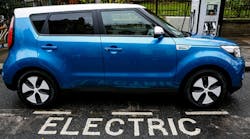Electric Vehicles Will Revolutionize Transportation Supply Chain
As the internal combustion engine is phased out in favor of alternative propulsion systems, automotive supply chains will undergo a radical transformation, according to new research from Transport Intelligence (Ti).
The supply chain for the entire powertrain will be transformed and the types of components, the logistics processes employed to move them, the markets of origin and destination as well as the tiered character of automotive supply chains will change.
“Fundamentally there is a shift in the nature of the components used, from mechanical engineering to electrical and electronic engineering,” said report co-author, Thomas Cullen, senior analyst at Ti. “The economics of both designing and producing these components is very different. This has enormous implications for how the automotive supply chain is ordered.”
Key findings in the new report – It Future Mobility: Electric Vehicle Supply Chain Architecture – include:
- As the dominant technology in electric vehicles, battery manufacturing processes will transform the automotive supply chain
- Battery or battery pack producers with high volumes will drive out lower volume manufacturers, including many vehicle manufacturers’ own in-house operations.
- Supply chain and logistics providers will adapt to the geography of battery and electric component production locations
- The integration of the battery pack and associated drive-train elements will create a distinctive ‘propulsion platform’
- The complex and deeply integrated tier-system of suppliers feeding in the components will change fundamentally.
Whilst batteries are complex pieces of engineering, they are much more straightforward to insert into a vehicle than an internal combustion engine. Plugging in the electric motors to the battery is a comparatively simple process. With no welding shop, no engine plant and a higher level of outsourcing to new component suppliers, the automotive assembly facility will shrink in scale along with its logistics requirements.
“Conventional vehicle manufacturers define assembly as a core-competence but with the changing nature of operations this may no longer be the case,” said Nick Bailey, Ti’s Head of Research and the report’s co-author. “It may be that, in time, automotive manufacturers’ come to focus on the design and marketing of their product, in the way that Apple does.
The impact of the reduction in parts and the elimination of tiers of suppliers in the powertrain supply chain might be considered to be traumatic enough for the automotive supply chain. However, in addition to this, the process of the manufacture of batteries in terms of materials, skills and existing production structures has developed outside of the main automotive powerhouse economies. Japan, South Korea and China are dominant in the sector, sourcing their raw materials from Asia, Africa and Latin America. Europe and North America have, with a few exceptions, been sidelined in the development of new technologies of batteries as well as in the manufacturing know-how.
One important discrete aspect of any EV supply chain that will make it distinct from IC supply chains is the differing nature of the interconnection of components. Whereas the relationship between components in IC vehicles is pre-dominantly kinetic, the relationship between electric and electronic components is reliant on the movement of electrons. This means that the nature of different component’s interfaces is very different. This obviously has major supply chain implications.



